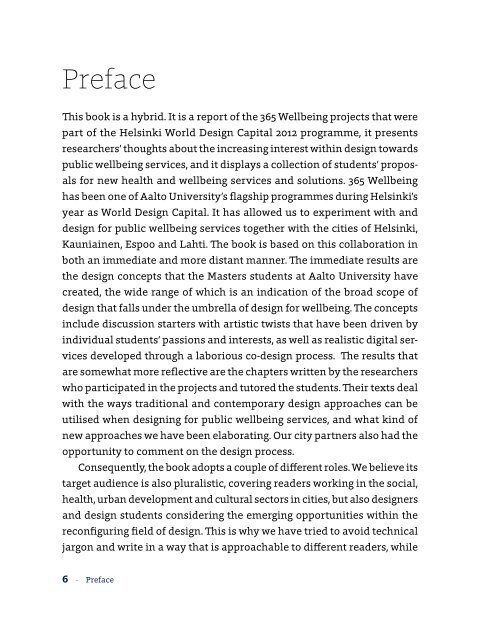Designing for wellbeing
Designing for wellbeing
Designing for wellbeing
Create successful ePaper yourself
Turn your PDF publications into a flip-book with our unique Google optimized e-Paper software.
Preface<br />
This book is a hybrid. It is a report of the 365 Wellbeing projects that were<br />
part of the Helsinki World Design Capital 2012 programme, it presents<br />
researchers’ thoughts about the increasing interest within design towards<br />
public <strong>wellbeing</strong> services, and it displays a collection of students’ proposals<br />
<strong>for</strong> new health and <strong>wellbeing</strong> services and solutions. 365 Wellbeing<br />
has been one of Aalto University’s flagship programmes during Helsinki’s<br />
year as World Design Capital. It has allowed us to experiment with and<br />
design <strong>for</strong> public <strong>wellbeing</strong> services together with the cities of Helsinki,<br />
Kauniainen, Espoo and Lahti. The book is based on this collaboration in<br />
both an immediate and more distant manner. The immediate results are<br />
the design concepts that the Masters students at Aalto University have<br />
created, the wide range of which is an indication of the broad scope of<br />
design that falls under the umbrella of design <strong>for</strong> <strong>wellbeing</strong>. The concepts<br />
include discussion starters with artistic twists that have been driven by<br />
individual students’ passions and interests, as well as realistic digital services<br />
developed through a laborious co-design process. The results that<br />
are somewhat more reflective are the chapters written by the researchers<br />
who participated in the projects and tutored the students. Their texts deal<br />
with the ways traditional and contemporary design approaches can be<br />
utilised when designing <strong>for</strong> public <strong>wellbeing</strong> services, and what kind of<br />
new approaches we have been elaborating. Our city partners also had the<br />
opportunity to comment on the design process.<br />
Consequently, the book adopts a couple of different roles. We believe its<br />
target audience is also pluralistic, covering readers working in the social,<br />
health, urban development and cultural sectors in cities, but also designers<br />
and design students considering the emerging opportunities within the<br />
reconfiguring field of design. This is why we have tried to avoid technical<br />
jargon and write in a way that is approachable to different readers, while<br />
6 · Preface
















